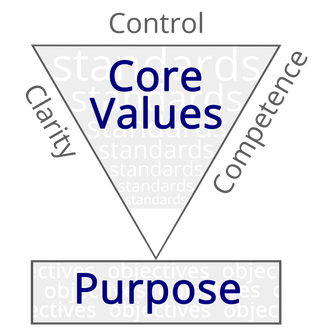Guide to...
EMS Course DescriptionWhat if there was a skill that could kill patients (and organizations), but you never got any training or feedback on it?
Most EMS leaders (Chiefs, Captains, Lieutenants, EMTs, etc.) aren’t actually taught how to lead, they’re just expected to do it. We’ll get you started in the right direction in this in-depth discussion about how to create the right organizational culture and why it’s important, with lessons and frameworks gathered together from the military, law enforcement, and EMS. ---------> Give feedback! <--------- ---------> Google Slides notecard <--------- |
1. AlignPurpose & Core Values
|
2. ReinforceStandards & Objectives
|
3. CascadeControl, Clarity, Competence
|
Why this workshop?
How many of these warning signs are you experiencing on your team?
|
|
|
Five Dysfunctions of a Team Quiz which was digitized and adapted from this test hosted on the Brigham Young University website.
- Build Trust - Small groups encourage inquiry over advocacy.
- Encourage Conflict - Aim for conflict that is constructive but NOT artificial harmony! Useful rules for meetings:
- 1. If you remain silent, you disagree. - Everyone must participate, forces others to engage silent members.
- 2. Everyone must formally commit to the decision(s) at the end of the meeting. - Everyone needs to be on board with decisions, regardless of their position during the discussion.
- 1. If you remain silent, you disagree. - Everyone must participate, forces others to engage silent members.
- Hold People Accountable - Be comfortable holding your team accountable, and you're less likely to have to do it. Be KIND not NICE!
- Focus on Results - Team comes first! If you don't achieve results, you're not actually a good team.
Further Reading:
Image: 5 Dysfunctions Pyramid
Article: Culture over Cash Glassdoor Survey
Book: The Advantage by Patrick Lencioni
Book: The Five Dysfunctions of a Team by Patrick Lencioni
Book: Culture Rules by Mark Miller
Poem: The Laws of the Navy by Admiral R.A. Hopwood, RN (Retired)
Image: 5 Dysfunctions Pyramid
Article: Culture over Cash Glassdoor Survey
Book: The Advantage by Patrick Lencioni
Book: The Five Dysfunctions of a Team by Patrick Lencioni
Book: Culture Rules by Mark Miller
Poem: The Laws of the Navy by Admiral R.A. Hopwood, RN (Retired)
1. Align: Why You Exist
|
Purpose
Definition: What you want to achieve or make happen by working together. Actions: Ask yourself "Why?" five times and use the determine your purpose exercise adapted from Jim Collins' breakout room sessions. The Toddler Test [Watch The Office video here]
Purpose and core values should make sense to a child! Ask yourself “Why” five times, like a toddler in the backseat of a car. |
Core Values
Definition: Most important ideas and beliefs that guide how we behave and make decisions. Linked to purpose! Actions: Determine your values exercise which was adapted from Jim Collins' breakout room sessions. |
Further Watching:
Ted Talk - Simon Sinek: How great leaders inspire action
Further Reading:
Book: Good to Great by Jim Collins
Book: Start with Why by Simon Sinek
Article: Make Your Values Mean Something by Patrick Lencioni
Article: A Brief Intervention to Improve Lifeguard Surveillance at a Public Swimming Pool
Ted Talk - Simon Sinek: How great leaders inspire action
Further Reading:
Book: Good to Great by Jim Collins
Book: Start with Why by Simon Sinek
Article: Make Your Values Mean Something by Patrick Lencioni
Article: A Brief Intervention to Improve Lifeguard Surveillance at a Public Swimming Pool
2. Reinforce: Two Types of Goals
|
Standards (Process Goal)
Definition: Guidelines for behaviors and actions you expect from others and strive for at all times. Useful Mantras:
Actions: Establish 1 memorable standard of behavior tied directly to 1+ core value. |
Objectives (Outcome Goal)
Definition: Clear, measurable, specific targets and results you want/need to achieve. Actions: Set 2 SMART goals (a medium- and a long-term goal), then SPEAR them! |
Further Reading:
Book: The Program by Jake MacDonald and Eric Kapitulik
Book: The Program by Jake MacDonald and Eric Kapitulik
3. Cascade: Leader-Leader Model
|
Control
|
Clarity
|
Competence
|
How to make decisions:
- “Yes, if”
- Does it align with/reinforce our core values?
- Since standards align with/reinforce core values, it should be up to standard if the answer here is yes!
- Does it align with/reinforce our purpose?
- Since objectives align with/reinforce core values, it should in service of an objective if the answer here is yes!
- Is this based on data not opinions?
- Does control cascade downwards?
Further Reading:
Book: Turn the Ship Around by L. David Marquet
Book: Work Rules by Laszlo Bock
Article: The Flywheel Effect by Jim Collins
Article: A Message to Garcia by Elbert Hubbard
Tradition Poster
Book: Turn the Ship Around by L. David Marquet
Book: Work Rules by Laszlo Bock
Article: The Flywheel Effect by Jim Collins
Article: A Message to Garcia by Elbert Hubbard
Tradition Poster
Want to fix YOUR organization?
We're more than happy to help, wherever you are! Feel free to reach out by emailing us at [email protected]

